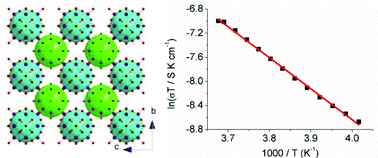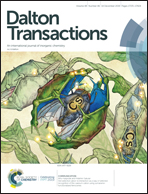A CsCl-type inorganic cluster-based high-symmetry crystal built from {Mo4.55V7.45PO40}10.45− with a high ratio of vanadium to molybdenum and {(H2O)0.3@K6(H2O)12}6+ clusters exhibiting proton conduction below the freezing point of water†
Abstract
As a class of anionic oxoclusters of early transition metals in their highest oxidation states, polyoxometalates (POMs) show considerable structural versatility and unique chemical and physical properties, making them promising multifunctional materials. In this study, a Keggin-type POM has been achieved, with a formula of [(H2O)0.3@K6(H2O)12]H4.45[PV7.45Mo4.55O40]·11H2O (1), and its microcrystals and nanocrystals have been obtained, respectively. This POM was characterized by elemental analysis for C, H and N, ICP-MS, TG, PXRD, SEM, X-band EPR and XPS techniques. Single crystal X-ray diffraction analysis demonstrated that 1 shows a rare extended structure with a high-connected three-dimensional (3D) all inorganic network of a Keggin-type POM, built from {Mo4.55V7.45PO40}10.45− polyoxoanions and {(H2O)0.3@K6(H2O)12}6+ clusters with CsCl-type crystal structure. In addition, to the best of our knowledge, 1 shows the highest ratio of vanadium to molybdenum among Keggin-type POMs reported thus far. Most interestingly, 1 exhibits intrinsic proton conduction below the freezing point of water, with a proton conductivity of 6.90 × 10−7 S cm−1 at 249 K and further reaching 3.36 × 10−6 S cm−1 at 272 K and Ea = 0.44 eV at 249–272 K.



 Please wait while we load your content...
Please wait while we load your content...